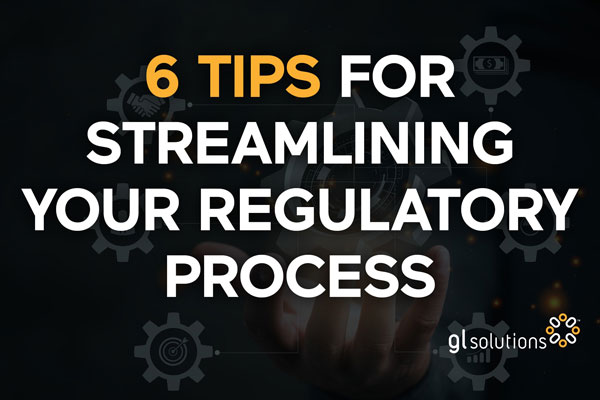Learn 6 tips for streamlining your regulatory process. Start by setting goals and end by embracing the never-ending challenge to improve continuously. And read about a stand out regulatory agency leader who knows how to succeed by crunching numbers and always “pushing the envelope to become better.”
Tip 1: Understand your mission and processes.
Begin the journey of streamlining your regulatory processes by first thoroughly understanding the strategic mission of your agency.
Take these steps to help nail down your regulatory agency’s vision:
- Describe what your agency values. Honesty? Efficiency? Customer service? Make a list of all of them.
- Understand your key stakeholders—who you serve, along with others you work with. For example, for a youth and family services department, stakeholders include the people that own and operate facilities that need a license—and ultimately the children those facilities serve. “It is almost like a multi-layered stream of stakeholders,” explains Sam Hardin, Vice President of Business Solutions at GL Solutions.
- Imagine a world without your agency to help you visualize the difference your agency makes. For example, a dental board licenses dentists to protect patients and minimize malpractice.
- Review your mission over time. Check in with key stakeholders about your core values. Revise the mission, if needed, to reflect current values.
“Start with your organization’s purpose from a very high level—your strategic mission,” explains Hardin. Consider leaning on artificial intelligence, such as ChatGPT, to help guide you through a mission-crafting process, plugging in the key details to create the finished statement.
After you understand your mission, break each of your licensing and permitting processes down into steps. Who completes the processes? One person or multiple people? Identify how the licensees get involved in the process, whether a simple application or a multi-step process.
Tip 2: Know the state statutes you must comply with.
Know the laws of your state that your agency helps to support. In addition, “these laws help to create structure—or agreed upon boundaries—for your agency,” explains Hardin.
Most importantly, your processes must help uphold these laws. As you review your processes, ensure that your step-by-step business processes support your state’s statutes and regulatory requirements.
A report from the National Governors Association highlights efforts to streamline regulations at the intersection of state laws and business processes. Learning From State Regulatory Streamlining Efforts features state efforts to streamline regulatory systems and processes. The report suggests creating an inventory of regulatory rules and requirements, and cites Arizona, as a state that reviews rules every five years.
Tip 3: Set goals and milestones.
“Set goals to adequately service your licensee population—and to protect those you serve,” says Hardin. These goals also help your agency meet state laws. Examples of these regulatory agency goals include processing an application within a certain time frame or receiving a specified number of licensing applications.
Certain types of professions struggle with shortages post-COVID, like nurses and teachers; setting goals for the license applicant numbers helps you tackle and face those shortages. And setting goals helps guide the creation of your licensing and permitting processes, and helps analyze the throughput of those processes. A state struggling with too few child care facilities, for example, sets a goal to increase the number of child care facilities in the state.
Measure your agency’s progress against these goals and milestones. Find out if your business processes work—or fail—to help you achieve these goals.
Setting goals also enables you to measure your regulatory agency against these goals, helping you gauge the success of your agency’s efforts.
Use these ideas to set goals for your agency:
- Reflect on your regulatory agency’s mission to set goals that reflect the core values of your organization.
- Talk to your licensee population. You need to thoroughly understand what matters to them. Use surveys, panels, town hall meetings, even your largest licensee, to grab that feedback. Track their feedback, whether they prioritize timely renewals or online applications. If they wish to apply for licenses online, for example, then set a goal to achieve a certain percentage of online applications. “For most of the agencies, their mission focuses on servicing the licensee population, so why not just ask them directly?” says Hardin.
Unfortunately, when a regulatory agency fails to set these goals and standards, others step in—like the governor—to mandate hitting certain metrics. Or agencies get sued or receive negative publicity for failing to meet core values, like protecting foster children, for example.
Some regulatory agencies, needing to uphold federal mandates, must report their metrics to the federal government too. So, agency goals not only come from within, but from outside authorities, as well, like the United States Department of Health and Human Services. And for other agencies, they lack an authority to provide those outside checks on regulatory compliance.
Tip 4: Know the tools to support the process.
“You clearly understand your business processes from A to Z. Now you need to start comparing that against the tools used to execute those processes,” says Hardin.
Oftentimes those tools, especially with the march towards modernization, come in the form of regulatory agency software. But besides software, other tools for your agency perhaps include a walk-in reception area to handle face-to-face inquiries. If your tools include paper applications and filing cabinets, take a phased in approach to modernizing your system.
If you lack the necessary tools, then you need to create a plan to procure those tools, such as regulatory software. As you contemplate the regulatory system of your dreams, remember to keep your budget in mind.
To procure new tools, review these items:
- Assess needed tools.
- Review required budget.
- Create procurement plan.
Tip 5: Use a change management process.
Hardin reveals the “most impactful” tip. “Once you identify a tool and how to procure that tool, you must adopt a change management process internally.” Along with that, your regulatory agency needs to communicate that process—and get buy in from others. Streamlining your regulatory processes requires that ability to adapt and change.
“And if you are not able to adapt and change,” says Hardin,” you will never be able to streamline your process. Ever.”
The Harvard Business School defines change management, identifying two types of change—adaptive and transformational. Applying a tool, like licensing and permitting software, to your business processes offers an example of transformational change. “Transformational changes are larger in scale and scope and often signify a dramatic and, occasionally sudden, departure from the status quo.”
Use these ideas to prepare for transformational changes:
- Share the upcoming changes with your licensee population.
- Let your regulatory staff know about the changes and the new tools.
- Create a plan for that change; if your change involves new software, work with your software provider on a project plan and schedule. A scope document or management plan from your software vendor helps outline how to work together, such as setting important due dates for various deliverables.
- Implement the new tool.
- “You always have to do this,” explains Hardin. “A lot of people miss this step and don’t think about this, but when you’re going through transformational change, it’s huge. There’s so much change that you’re going to have to go back and reanalyze or recalculate.” Review the new challenges or roadblocks that erupt because of the change. If you now use software to issue licenses, for example, that changes the way your staff perform their job.
- Embed the changes within the culture and practices of your regulatory agency. Create buy in and let staff know we work in this new way. You now use the new regulatory solutions to help you achieve your mission and goals.
- Review again. “Once you change the culture,” explains Sam “and everyone uses the tool, with the news structures and controls around that tool, then review progress and analyze results.”
Tip six: Improve continuously.
“If you’re trying to streamline your regulatory processes, it’s not enough to just implement a change and be done. You’re going to have to continuously improve,” says Hardin. He explains you need to foster an environment of continuous improvement with agency modernization; you review your goals and your objectives and constantly reevaluate those.
Your leadership needs to lead the way with continuous improvement. However, if they choose not to, sometimes state statutes or technological advancements force that change. For example, using antiquated regulatory solutions, like paper or even typewriters, continues to dwindle, as state government agencies switch to automated regulatory software. These digital solutions enable your agency to hit your goals and objectives—and continuously improve.
Ways to improve continuously:
To improve, you need a leader that places value on continually improving. Hardin points to the Executive Director for the Arizona Barbering and Cosmetology Board Frank Migali. “AZBOC is successful because Frank is continually pushing the envelope to become better.”
He describes how Migali puts continuous improvement into action. Use his tactics for success at your regulatory agency:
- Analyze data to determine if your agency met goals.
- Ask if opportunities exist to improve.
- Review tools you use and consult with your regulatory solutions provider.
- Interview staff about their roadblocks.
Besides your own leadership efforts, engage the industry experts at your software solutions provider to help you continuously improve. Your vendor helps by communicating industry trends like how to apply AI at your regulatory agency. In addition, a regulatory software vendor helps your agency improve continuously with webinars and other instructional videos.
Time to Modernize
GL Solutions helps your regulatory agency run, grow and adapt through modern software and automation that helps solve your agency’s greatest challenges. To learn more, contact us.
To receive the latest regulatory news delivered to your inbox each week, subscribe to our newsletter.


